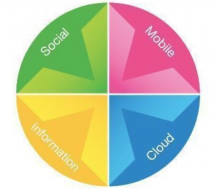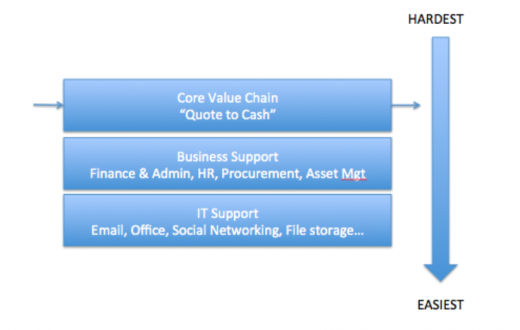
| This post is brought to you by Comcast Business. Follow us @comcastbusiness. |
If you believe the adverts, it seems that more and more major corporates are committing to “the cloud”. Many are claiming, or at least the vendors providing their application are claiming, that it is transforming their businesses. According to a recent survey, 49% of executive-level managers think cloud computing will transform their business.
So is it inevitable that this is the only way that applications will be delivered in the future? And if so, should every CEO and CIO be thinking about how they make the transition?
The future is here, but unevenly distributed
There are high-profile clients who are implementing cloud-based applications, but only in certain areas of their businesses. They are getting business benefits that are often driven by their IT investment cycle, industry challenges or their company vision and strategy. Therefore, there is no “one size fits all” ROI calculator. Sorry. However there are some common themes that I will touch on later.
But you need to look behind the hype and marketing. There are very few major corporates, which can probably be counted on one hand, who have committed 100% to the cloud for all their IT applications. Those who are 100% cloud were probably “born in the cloud” so have launched and become major corporations within the last 3-5 years. Everyone else is struggling with the legacy-migration challenge.
Where are cloud applications making an impact?
There are number of factors that determine the ease of transition to cloud applications and the benefits that a corporation is like to get.
Firstly, the further you are away from the core business operation, the easier it is. Often, our impression of the wholesale shift to cloud computing is swayed by the ads or case studies of major corporations who have transferred all their email accounts and office productivity applications to Google or Microsoft. This is relatively easy to do as there are few, if any, integration points back into core applications and there can be some clear cost savings. This is also why social enterprise software has managed to penetrate the corporation when it is only offered as a cloud solution, and collaborative file sharing is being implemented in the cloud.
In the area of business support, there are companies who are implementing cloud applications such as Finance and Admin, HR, Procurement and Asset Management. These are more difficult as the number of interfaces back into the core systems increases. Often, these applications are being transitioned into the cloud as part of a wholesale outsource of the function to a third party, or the move to a shared service center. A share service center normally requires a consolidation of a huge range of IT systems that have been implemented in the different divisions, business units or regions. The largest number I have heard of was over 1,000 implementations of SAP inside a single client, but it is not uncommon to have 50 different versions of SAP, Oracle, JEdwards, Peoplesoft etc. So, often the simplest solution is a brand new implementation, and then a cloud offering is considered, and relative cost saving and ease of installation is a deciding factor.
There are some areas of core systems where cloud applications are gaining headway, the most obvious being sales and support. However, we are yet to see any significant traction displacing the core operational ERP systems of SAP and Oracle in major corporations. This is not surprising, as clients have spent hundreds of millions of dollars installing, configuring and customizing them. They have decades of legacy data. Unless there is a significant financial benefit, some major company catalyst, or an industry upheaval, these systems are here to stay.
Benefits
The ROI case for implementing the cloud in most cases will excite the CIO or CFO. Not the CEO. Certainly not the VP Strategy.
The benefits are:
- Cost savings or cost apportionment; Cloud-based applications are often consumption-based so quarterly fees are associated with the number of users. The cost may be higher in the long run, but the annual costs are lower. This is particularly true in major corporates who often sign high-priced ELA’s which give them access to a wide range of software license they may, but rarely use.
- More workforce flexibility; As cloud based applications can be accessed by employees from wherever they are, there is no need for them to commute to an office or log onto a corporate network through some company VPN. They can be at work 24 x 7. The flexibility enables some corporate processes to be reinvented and made more efficient; e.g. mobile insurance claims assessor, follow-the-sun design or crowd-sourced helpdesks.
- Better systems resilience and security; Often the cloud vendor will have better backup, disaster recovery and security than the client. They are more likely to up to date on operating system and networking and software fixes and patches. It is what they major on and are measured on. Nevertheless, security is still raised as a major concern by CIOs.
- Ability to scale; Unforeseen increases in capacity are handled by the cloud vendor who is balancing the load across many clients. That reduces the level of redundant infrastructure the client would have needed to invest in, if the applications were in-house. That scaling could be also be the client opening up offices in new regions, which with a cloud application can be achieved with relatively little investment in infrastructure.
But these are not benefits are transformational. And yet we hear that the cloud will enable entire industries to reinvent themselves. So why are we not seeing this?
Transformation requires the Nexus of Forces
A simple move to a cloud-based application is really only changing the delivery platform. It is tinkering with systems, and then only at the margins. It is not having a significant impact in corporations. Although it is causing major changes inside corporate IT organizations who are having to reshape themselves and adapt to new ways of working.
The industry-changing transformation is not driven from the cloud. Not alone. What is having the greatest impact – reforming industries, allowing young upstarts to complete wrong-foot large established companies, creating whole new industries – is a combination of technology trends that are all hitting at the same time. Gartner calls them the Nexus of Forces; cloud, social, mobile, information (big data). Forrester calls them Digital Disruption.
 Gartner describes it as “The Nexus of converging forces — social, mobile, cloud and information — is building upon and transforming user behavior while creating new business opportunities. Research over the past several years has identified the independent evolution of four powerful forces: social, mobile, cloud and information. As a result of consumerization and the ubiquity of connected smart devices, people’s behavior has caused a convergence of these forces.”
Gartner describes it as “The Nexus of converging forces — social, mobile, cloud and information — is building upon and transforming user behavior while creating new business opportunities. Research over the past several years has identified the independent evolution of four powerful forces: social, mobile, cloud and information. As a result of consumerization and the ubiquity of connected smart devices, people’s behavior has caused a convergence of these forces.”
Whilst most people recognise these forces at work in their personal and business lives, it is the implications that are either liberating or terrifying. For those business leaders looking to leapfrog their competition or a nimble start-up looking to wrong foot an incumbent it is an exciting time. However, Gartner raised a warning to senior IT leaders: “Existing architectures are becoming obsolete.”
But there is another group of people who need to be aware of the coming forces. The CEO and their strategic thinkers need to consider how these forces will reshape their industry, and the part they play in it. These forces are dramatically changing businesses. In some cases destroying the current business model causing a complete reinvention. Think about the music, media and publishing industries. But every business model is at risk. Often it is the role of the CIO to start to engage with CEOs in the debate.
Forrester has described the impact of these business trends as “Digital Disruption”. The key principles behind digital disruption are that it creates new business models, changes value streams, and is faster, more disruptive and more pervasive than any earlier change driver. Why? Because it is digital. And Forrester says that for those thinking that hunkering down and letting it blow past, as with previous trends – forget it. This is not a trend. It is a permanent shift.
The perfect storm
This may all feel like scaremongering, but the Nexus of Forces is the “perfect storm” of technology changes coming together which will reshape every business on the planet. Each individual force is powerful. I am sure you can see how mobile can transform elements of your business. Or how access to big data is changing the relationship you can have with your customers. But it is how the different forces – cloud social, mobile, information – combine that enables entire industries to be reinvented and new industries to emerge.
A simple (hypothetical) example: Smart parking meters
Every parking meter streams data to the cloud with either a digital recognition of the number plate of the car parked in the space or the fact that the space is free.
What are the implications? Firstly, every car that is parked when the meter runs out is automatically fined. This eliminates the need for parking attendants. But then it opens up the opportunity for a new business, which is a mobile app that combines the parking data with geolocation data from the phone to help people find the nearest parking space. Perhaps for premium users it gives them the best spaces or the ability to pre-reserve a parking space. That same service can allow payment of parking online, so no searching for the right coins. Finally smart meters allow for differential parking rates – with higher rates at peak times potentially changing people’s parking behavior – and help optimize parking space utilisation. Using parking data, town planners have more insights into the design of roads and parking to make for cleaner and safer towns.
All the technology is already in existence. But think of how the local town’s parking departments, parking ticket collections, parking attendant teams, those that empty parking meters and even town planners have changed.
A real example: Zipcar
Without the Nexus of Forces, Zipcar could not have operated cost-effectively. Zipcar is fractional ownership of cars. Cars, owned by ZipCar, are parked in pre-allocated slots in major cities. They have a device attached to the windscreen that transfers location, usage and other driving information back to the HQ. But it also enables the car to be unlocked by a Zipcar user’s card, provided the car has been booked by the user. The user books the car via a website or mobile application. Cloud, mobile and information combining here to make the service possible. The interesting social aspect is that the cars need to be left clean and with at least a quarter tank of gas. Peer pressure, the easy ability for the next user to report a dirty or damaged car, and knowledge that the driving style is (probably) being recorded means that the cars are treated with respect, unlike hire cars.
A new industry ripe for reinvention
The healthcare industry in the US is an expensive political hot potato. The cost of medical insurance is spiralling out of control but it seems that there are too many different organisations with vested interests to be able to reform it effectively. Enter the Nexus of Forces. There are a number of companies launching that are now able to provide specific medical, fitness and health data on individuals that would enable insurers to provide more customized or targeted quotes. It’s rather like the black boxes fitted to cars by insurance companies that record driving styles and reward better drivers with lower premiums.
Suddenly those who live healthier lifestyles and are less likely to cause themselves to use medical insurance, barring unforeseen accidents, will have lower premiums. But it goes further than that. There is now a strong correlation between healthier and happier employees and their productivity. So it is worth companies encouraging their employees to get fitter. And now these applications can connect us with likeminded individuals so collectively we can hit our fitness goals. We win, our employers win, our healthcare system wins. But this is being driven by a range of technologies provided by private corporations, all working in concert due to the Nexus of Forces.
With concerns of the rising levels of obesity across the country, destroying lives and bleeding our healthcare system dry, this could be the greatest benefit that cloud computing could bring.
What could the Nexus of Forces do to your industry?
Sure, you can move all your email to the cloud or implement social software to improve employee collaboration, but that is not really moving the needle. Now is the time for the executive teams in corporations to be thinking very creatively about cloud computing combined with mobile, social and information could do.
It will be scary and exciting. It will be challenging and threatening. It will be difficult because it will mean potentially confronting the end of business as they know it. It may need an external facilitator who has no vested interest in the past or the future. But it needs to be done, because if it isn’t, I can guarantee you there is a small team of entrepreneurs somewhere plotting to build a company that will harness these forces and become a disruptive force for change.
Image credit: Maksym Darakchi / Shutterstock
Get the TNW newsletter
Get the most important tech news in your inbox each week.





